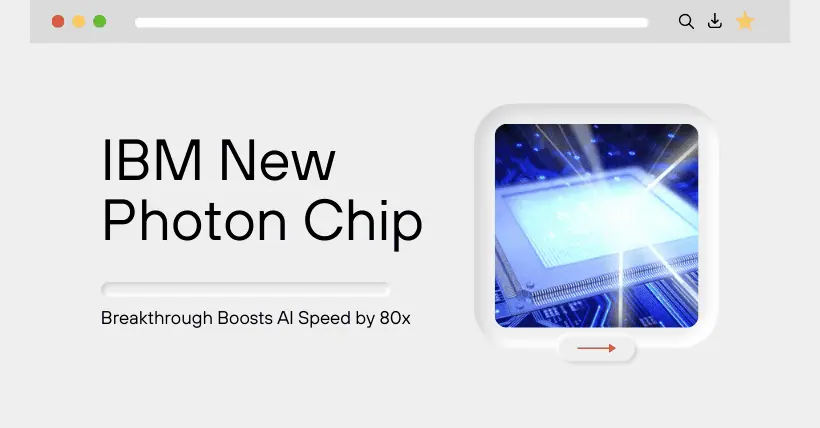IBM has developed a new polymer waveguide (PWG) technology that brings innovation to co-packaged optics.
IBM states that it has made a breakthrough in optical technology that can significantly improve the way data centers train and run generative AI models. Its new co-packaged optical technology essentially integrates the power of optical fibers onto the chip, enabling connections within the data center at the speed of light.
Mukesh Khare, General Manager of IBM Semiconductor, mentioned that the telecom industry has made significant progress in manufacturing faster chips. However, the communication speed between these chips has not increased at the same rate. There is a several-order-of-magnitude gap between the growth rate of computation and the speed of communication between chips.
He said, “Essentially, the more basic chips still communicate via electricity. They use copper wires. As we know, the best communication technology we have is fiber optics, which is why fiber optics is used for long-distance communication elsewhere.”
Although co-packaged optical technology has existed for some time, IBM has created a new polymer waveguide (PWG) technology to power co-packaged optics. PWG allows chip manufacturers to add more than six times the amount of fiber optics to the edge of silicon photonic chips. Each fiber optic is about three times the width of a human hair, with lengths ranging from a few centimeters to hundreds of meters, and can transmit data at several terabits per second.
1. What does this mean?
The company states that this technology enables chip-to-chip communication bandwidth that is 80 times faster than today’s electrical technology-based communication and can reduce power consumption by more than five times.
It can also speed up the training of large language models (LLMs) by five times, reducing the time required to train a standard LLM from three months to three weeks. Additionally, using larger models and more GPUs can enhance performance.
Besides enabling faster communication between GPUs and accelerators, it can redefine how the computing industry transfers high-bandwidth data across circuit boards and servers.
Khare said, “We are thrilled to leverage the power of light to accelerate the development of Gen AI and many other applications.”
When asked about the commercialization of this technology, Khare stated that IBM’s research department is ready for deployment.
Recently, the development of electronic chips has faced significant physical and economic challenges, and the voices claiming that “Moore’s Law has failed” have become louder. Electronic chips, based on silicon, face problems such as electrical surges and electron breakdown when the process shrinks below 7 nanometers, making them difficult to control. In contrast, photonic chips provide a new solution that not only overcomes power consumption and memory access bottlenecks but also creates many unprecedented application scenarios.
2. The Race for Photonic Chips
Currently, photonic chips are sparking intense competition among top research institutions worldwide. For example, the research team from Tsinghua University in April 2023 proposed a novel distributed breadth-intelligent optical computing architecture and developed a photonic chip called “Taiji,” which is several orders of magnitude more energy-efficient than current smart chips. This technology shows great potential in large-scale intelligent analysis and large model training.
So, how do photonic chips work? Electronic chips rely on electronic transistors and conductive copper wires, while photonic chips are based on photonic transistors and optical waveguides. Waveguides are the medium for transmitting optical signals, similar to the fiber optics we commonly encounter. Photonic chips can be divided into laser chips and detector chips. Laser chips excite currents through semiconductor materials to achieve electro-optic conversion, while detector chips convert optical signals into electrical signals through the photoelectric effect.
Although pure photonic chip research is still in the experimental stage, most photonic chips still require electricity for control. It is reported that Tsinghua University’s “Taiji II” chip has demonstrated the possibility of online training through optical neural networks, capable of high-speed data processing without the need for GPUs. This progress provides hope for the commercialization of photonic chips.
Photonic chips not only excel in computing but will also show their application potential in many fields. Due to their ultra-fast data transmission capabilities and integration with optical fiber networks, photonic chips can usher in a new era of communication technology. The interference-resistant properties of photonic technology make the development of photonic radar possible, and in fields like biomedical and environmental monitoring, photonic chips can enable more efficient data processing and analysis.
Commercializing photonic chips will still face multiple technical and cost challenges. Once these hurdles are overcome, the widespread use of photonic chips will not only signify a technological breakthrough but could profoundly change various aspects of our lives.
Related:
- Everything You Need to Know About Silicon CPO Technology
- AI Chips vs CPUs: Who Wins in Performance Race?
- IBM and Rapidus Partner to Develop 2nm Chip Technology
- Samsung Faces Setback, S25 Opts for Micron LPDDR5X
- Nvidia Forms ASIC Division, Aggressive Talent Hunt Underway
- Apple Chip Innovation: Why Not Selling Makes Sense
- Who is the Biggest Customer of NVIDIA AI Chips?
- TSMC 2nm Chips: 15% Faster, 35% More Efficient, 50% Pricier

Disclaimer:
- This channel does not make any representations or warranties regarding the availability, accuracy, timeliness, effectiveness, or completeness of any information posted. It hereby disclaims any liability or consequences arising from the use of the information.
- This channel is non-commercial and non-profit. The re-posted content does not signify endorsement of its views or responsibility for its authenticity. It does not intend to constitute any other guidance. This channel is not liable for any inaccuracies or errors in the re-posted or published information, directly or indirectly.
- Some data, materials, text, images, etc., used in this channel are sourced from the internet, and all reposts are duly credited to their sources. If you discover any work that infringes on your intellectual property rights or personal legal interests, please contact us, and we will promptly modify or remove it.



